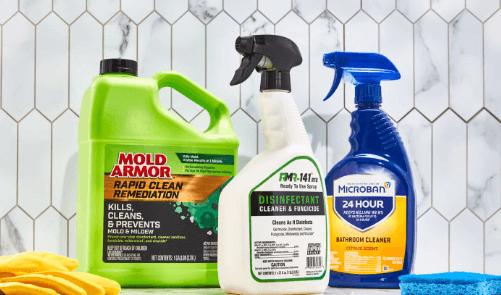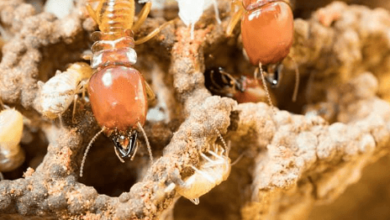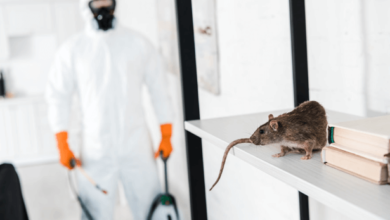How to Remove Mould and Mildew From Your Rental Property Before Moving Out?

HavingMould and Mildew in your green salad in the form of blue cheese is tasty and fancy, but seeing it on your bathroom tiles or between the door edges is repulsive and оoppressive.
The problem goes deeper when the property isn’t yours. If you live on rent, how and whether you are supposed to deal with the problem might be confusing.
Moreover, if this is the end of your lease contract and you observe some Mould and Mildew while making a tenancy cleaning checklist, you might be trapped in an awful situation.
How does mould occur?
Mould is not just an interior aesthetic issue: it can severely harm your health.
It’s also a common cause of allergic reactions on the skin, such as rashes, for instance, as well as respiratory system problems. All of these are because mould is nothing else but a fungus organism.
Moisture is what makes mould occur, exist and spread.
Once it starts breeding, it creates new spores that eventually grow and turn into new dark sports. But what’s worse is that apart from what you see on the walls, the tiles, etc., they also float through the entire domestic inner air.
In other words, fungal spores cannot be a specific room issue. It might affect the entire property if mould cleaning measures aren’t taken immediately.
Who is responsible for mould and mildew?
While you are asking yourself how to clean it, another question might arise in your mind. Who’s supposed to deal with it since the property is not yours, but you live on rent in it?
There’s no single answer because it depends on the specific conditions.
You have to know that as a tenant who’s just noticed the first Mould and Mildew, you should immediately inform your landlord about the issue. This might save you further health problems and expenses to get rid of it on your own.
Thus, if you have known there was a mould problem for a year or more, and now you are about to perform the end of tenancy cleaning, it would be your duty to eliminate not only the grime and spots around but also the fungus. Get your cleaning supplies in order, and be prepared to solve the issue.
Common types of mould and how to treat each of them
To learn how to clean mould most efficiently, you should first know what you are facing.
The thing is that there are different types of mould, respectively you might need different approaches to eliminate it:
- Mildew. It’s the most common type of mould. You can see it as black spots, mainly on the walls. Traditionally, wiping out with bleach can permanently remove the mildew.
- Green mould. Although it’s rare, you should know that it occurs as a fluffy formation. Note that just because it contains Penicillin, it doesn’t mean green mould is good for you, so you should better remove it through professional assistance.
- Blue mould. It’s typical for sanitary premises where there are leaks. Remove it through the traditional mould cleaning tips.
- White mould. You will see it in the damp cellars. It has a furry look and can sometimes be mistaken for powder deposits (like sugar, salt, etc.).
Toxic black mould safety precautions to have in mind
Beware of this type of mould because it’s extremely dangerous. You should better not take any measures against it, but instead, call specialists for help.
The toxic black mould might not be so common, but you have a serious problem if you spot it. By the way, it looks like the other standard mould types.
However, toxic black mould causes severe symptoms quite fast. Informing your landlord is a must. If you are in this situation right before the end of the tenancy cleaning team’s arrival, consult with the specialists on how to deal with this issue.
Practical and tested tips for efficient mould removal
Below we will try to present you some of the best and most practical tips on how to clean mould. You can use them in your rented property before moving out.
We strongly suggest you inform your landlord of the problem if you fail to solve it during the end of tenancy cleaning for the sake of the newcomers’ health.
Here’s what you can try to cope with this issue:
- Ordinary soapy solution with an all-purpose cleaning detergent can help you deal with the mould (if it’s on a small scale).
- If you see several different zones with mould around the premise, you better try to wipe it out with bleach.
- White vinegar has antibacterial properties that can kill the fungus, too.
- Dealing with mold without removing its cause of it has no point. Keeping moisture limited in the property is a must. So is making the required repairs in case of a leak.
- Do not start removing the mould – regardless of its type – without taking personal precautious measures. On mandatory, wear rubber gloves and a mask while wiping, brushing and scrubbing.
- Buying an eco-friendly anti-mold detergent from the store is also a good idea. Ensure you get a green product because the chemical can cause serious intoxication. Consider steam cleaning, as it is not only effective at killing mould spores, but it also saves money.
- If nothing works, opt for some professional assistance.
Conclusion
Living on rent and with Mould and Mildew might sound like a nightmare. However, if you take preventive measures in advance, you can avoid such unpleasant situations.
Informing your landlord at your earliest convenience and before the end of tenancy cleaning can save you all efforts. Even if you haven’t done what should be done at the right time, don’t panic. There is always a solution.
Try our DIY tips or, even better, turn to the experts for Mould and Mildew elimination.
In all cases, the fungus spores are dangerous for people’s health and should be removed immediately. Don’t postpone this moment, and do the task yourself or contact licensed cleaners instead, no matter how long you plan to stay in your rented property.







